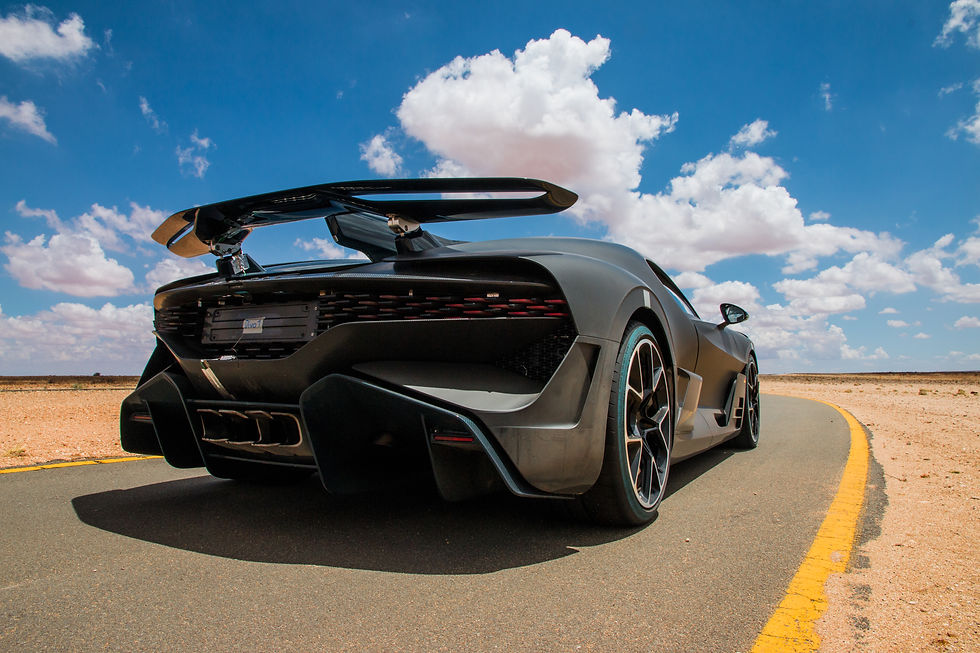FOR THOSE LUCKY FEW THE BUGATTI DIVO IS FINALLY HERE!
- Billions Luxury Portal

- Apr 29, 2020
- 3 min read
After two years of development, the limited edition hyper sports car will be delivered to it's customers starting this year ...
Exceptionally crafted, striking in character, strictly limited and with completely different handling performance – this is an entirely unique project: the Divo1is truly one of the most breathtaking and exclusive hyper sports cars of modern times. Priced at $5.4 million only 40 of these exceptional units have been crafted and all have sold out.
After a rigorous two-year development period, the first models of the coveted small series are now being delivered to customers.
Not surprisingly, the technology inside this agile performer is remarkable: it is powered by the 1,500 PS 8.0-litre W16 engine with 1,600 newton metres, which accelerates the Divo from 0 to 100 km/h in 2.4 seconds with a top speed of 230mph.
Bugatti's engineers managed to achieve this agility by using less weight, more downforce and a more direct chassis setup. This includes a change in wheel camber on the front and rear axles, harder springs and a more front-oriented balance. As a result, the Divo’s top speed is limited to 380 km/h. These measures increase agility, that is to say the vehicle’s response to the steering angle input. In addition, the Divo has shed a total of 35 kilograms in weight as compared to the Chiron thanks to systematic lightweight construction.

Bugatti also devoted particular attention to developing the aerodynamic properties of the Divo. The bonnet now has air inlets that reduce the frontal area of the vehicle and improve the air flow. An optimised air curtain provides enhanced air ducting in the front and rear areas of the vehicle sides. Meanwhile, the newly shaped front spoiler serves to increase downforce, directing more air to the front air intakes. This supplies the cooling system with a greater air mass and increases overall cooling capacity. Four independent air sources on each side of the vehicle cool the brakes. Air comes from the high-pressure area above the front bumper, from the intakes on the front wings, from the intake at the front radiator and from the diffusers in front of the tyres. Blades guide the cold air onto the brake discs, while a heat shield directs the hot air directly through the wheels to the outside. This keeps the tyre temperature within the optimum range and prevents the brakes from overheating.
The experts even optimized the roof. In conjunction with the modified rear end, a high air mass flow into the engine compartment is achieved, thereby benefiting temperature management. At the same time, these measures prevent the air above the vehicle from swirling and developing turbulence at the rear wing. Fixed in height and 1.83 metres (72”) wide, the rear wing ensures a high level of downforce: it is 23 per cent wider than the rear wing on the Chiron, but its angle can still be adjusted for individual vehicle modes and continues to function as an air brake. The wing is supported by the rear diffuser, which is more efficiently designed and accommodates the four exhaust pipes.

In terms of design, the Divo also takes on a new path – clearly differentiated from the Chiron yet still instantly recognizable as a Bugatti. The designer team under Achim Anscheidt uncompromisingly configured the body form of the Divo for lateral acceleration, focusing on optimum aerodynamic and thermodynamic efficiency. These include a slimmer sideline and additional air intakes for brake cooling.
The extremely compact and lightweight LED headlights with a flat light aperture of only 35 millimetres (1 3/8”) are particularly striking, as are the highly complex 3D tail light modules. These form part of the rear grille, which is partly produced using a 3D printing process and has special lightweight fins. A total of 44 of these fins illuminate to form the tail light system. In the interior, new sports seats with higher side bolsters hold the occupants securely in their seats even when cornering at very high speeds. The steering wheel is partially covered in Alcantara and has enlarged steering wheel-mounted shift paddles on both sides. This enables drivers to change gears manually and experience even greater driving pleasure.






















